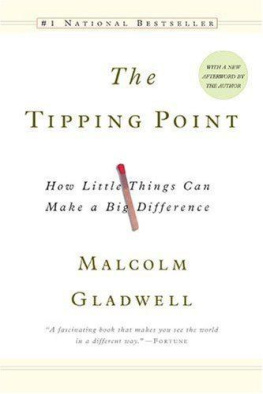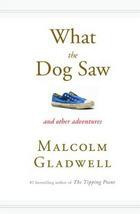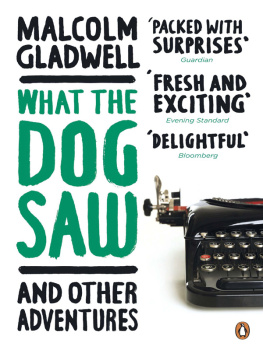A LSO BY M ALCOLM G LADWELL
Outliers
Blink
The Tipping Point
HAIR DYE AND THE HIDDEN HISTORY OF POSTWAR AMERICA
During the Depression long before she became one of the most famous copywriters of her day Shirley Polykoff met a man named George Halperin. He was the son of an Orthodox rabbi from Reading, Pennsylvania, and soon after they began courting he took her home for Passover to meet his family. They ate roast chicken, tzimmes, and sponge cake, and Polykoff hit it off with Rabbi Halperin, who was warm and funny. Georges mother was another story. She was Old World Orthodox, with severe, tightly pulled back hair; no one was good enough for her son.
Howd I do, George? Shirley asked as soon as they got in the car for the drive home. Did your mother like me?
He was evasive. My sister Mildred thought you were great.
Thats nice, George, she said. But what did your mother say?
There was a pause. She says you paint your hair. Another pause. Well, do you?
Shirley Polykoff was humiliated. In her mind she could hear her future mother-in-law: Fahrbt zi der huer? Oder fahrbt zi nisht? Does she color her hair? Or doesnt she?
The answer, of course, was that she did. Shirley Polykoff always dyed her hair, even in the days when the only women who went blond were chorus girls and hookers. At home in Brooklyn, starting when she was fifteen, she would go to Mr. Nicholass beauty salon, one flight up, and he would lighten the back until all traces of her natural brown were gone. She thought she ought to be a blonde or, to be more precise, she thought that the decision about whether she could be a blonde was rightfully hers, and not Gods. Shirley dressed in deep oranges and deep reds and creamy beiges and royal hues. She wore purple suede and aqua silk, and was the kind of person who might take a couture jacket home and embroider some new detail on it. Once, in the days when she had her own advertising agency, she was on her way to Memphis to make a presentation to Maybelline and her taxi broke down in the middle of the expressway. She jumped out and flagged down a Pepsi-Cola truck, and the truck driver told her he had picked her up because hed never seen anyone quite like her before. Shirley would wear three outfits, all at once, and each one of them would look great, Dick Huebner, who was her creative director, says. She was flamboyant and brilliant and vain in an irresistible way, and it was her conviction that none of those qualities went with brown hair. The kind of person she spent her life turning herself into did not go with brown hair. Shirleys parents were Hyman Polykoff, small-time necktie merchant, and Rose Polykoff, housewife and mother, of East New York and Flatbush, by way of the Ukraine. Shirley ended up on Park Avenue at Eighty-second. If you asked my mother Are you proud to be Jewish? she would have said yes, her daughter, Alix Nelson Frick, says. She wasnt trying to pass. But she believed in the dream, and the dream was that you could acquire all the accouterments of the established affluent class, which included a certain breeding and a certain kind of look. Her idea was that you should be whatever you want to be, including being a blonde.
In 1956, when Shirley Polykoff was a junior copywriter at Foote, Cone & Belding, she was given the Clairol account. The product the company was launching was Miss Clairol, the first hair-color bath that made it possible to lighten, tint, condition, and shampoo at home, in a single step to take, say, Topaz (for a champagne blond) or Moon Gold (for a medium ash), apply it in a peroxide solution directly to the hair, and get results in twenty minutes. When the Clairol sales team demonstrated their new product at the International Beauty Show, in the old Statler Hotel, across from Madison Square Garden, thousands of assembled beauticians jammed the hall and watched, openmouthed, demonstration after demonstration. They were astonished, recalls Bruce Gelb, who ran Clairol for years, along with his father, Lawrence, and his brother Richard. This was to the world of hair color what computers were to the world of adding machines. The sales guys had to bring buckets of water and do the rinsing off in front of everyone, because the hairdressers in the crowd were convinced we were doing something to the models behind the scenes.
Miss Clairol gave American women the ability, for the first time, to color their hair quickly and easily at home. But there was still the stigma the prospect of the disapproving mother-in-law. Shirley Polykoff knew immediately what she wanted to say, because if she believed that a woman had a right to be a blonde, she also believed that a woman ought to be able to exercise that right with discretion. Does she or doesnt she? she wrote, translating from the Yiddish to the English. Only her hairdresser knows for sure. Clairol bought thirteen ad pages in Life in the fall of 1956, and Miss Clairol took off like a bird. That was the beginning. For Nice n Easy, Clairols breakthrough shampoo-in hair color, she wrote, The closer he gets, the better you look. For Lady Clairol, the cream-and-bleach combination that brought silver and platinum shades to Middle America, she wrote, Is it true blondes have more fun? and then, even more memorably, If Ive only one life, let me live it as a blonde! (In the summer of 1962, just before The Feminine Mystique was published, Betty Friedan was, in the words of her biographer, so bewitched by that phrase that she bleached her hair.) Shirley Polykoff wrote the lines; Clairol perfected the product. And from the fifties to the seventies, when Polykoff gave up the account, the number of American women coloring their hair rose from 7 percent to more than 40 percent.
Today, when women go from brown to blond to red to black and back again without blinking, we think of hair-color products the way we think of lipstick. On drugstore shelves there are bottles and bottles of hair-color products with names like Hydrience and Excellence and Preference and Natural Instincts and Loving Care and Nice n Easy, and so on, each in dozens of different shades. Feria, the new, youth-oriented brand from LOral, comes in Chocolate Cherry and Champagne Cocktail colors that dont ask Does she or doesnt she? but blithely assume Yes, she does. Hair dye is now a billion-dollar-a-year commodity.
Yet there was a time, not so long ago between, roughly speaking, the start of Eisenhowers administration and the end of Carters when hair color meant something. Lines like Does she or doesnt she? or the famous 1973 slogan for LOrals Preference Because Im worth it were as instantly memorable as Winston tastes good like a cigarette should or Things go better with Coke. They lingered long after advertising usually does and entered the language; they somehow managed to take on meanings well outside their stated intention. Between the fifties and the seventies, women entered the workplace, fought for social emancipation, got the Pill, and changed what they did with their hair. To examine the hair-color campaigns of the period is to see, quite unexpectedly, all these things as bound up together, the profound with the seemingly trivial. In writing the history of women in the postwar era, did we forget something important? Did we leave out hair?
When the Does she or doesnt she? campaign first ran, in 1956, most advertisements that were aimed at women tended to be high glamour cherries in the snow, fire and ice, as Bruce Gelb puts it. But Shirley Polykoff insisted that the models for the Miss Clairol campaign be more like the girl next door Shirtwaist types instead of glamour gowns, she wrote in her original memo to Clairol. Cashmere-sweater-over-the-shoulder types. Like larger-than-life portraits of the proverbial girl on the block whos a little prettier than your wife and lives in a house slightly nicer than yours. The model had to be a Doris Day type not a Jayne Mansfield because the idea was to make hair color as respectable and mainstream as possible. One of the earliest Does she or doesnt she? television commercials featured a housewife in the kitchen preparing hors doeuvres for a party. She is slender and pretty and wearing a black cocktail dress and an apron. Her husband comes in, kisses her on the lips, approvingly pats her very blond hair, then holds the kitchen door for her as she takes the tray of hors doeuvres out for her guests. It is an exquisitely choreographed domestic tableau, down to the little dip the housewife performs as she hits the kitchen light switch with her elbow on her way out the door. In one of the early print ads which were shot by Richard Avedon and then by Irving Penn a woman with strawberry-blond hair is lying on the grass, holding a dandelion between her fingers, and lying next to her is a girl of about eight or nine. Whats striking is that the little girls hair is the same shade of blond as her mothers. The Does she or doesnt she? print ads always included a child with the mother to undercut the sexual undertones of the slogan to make it clear that mothers were using Miss Clairol, and not just fast women and, most of all, to provide a precise color match. Who could ever guess, given the comparison, that Moms shade came out of a bottle?
Next page







